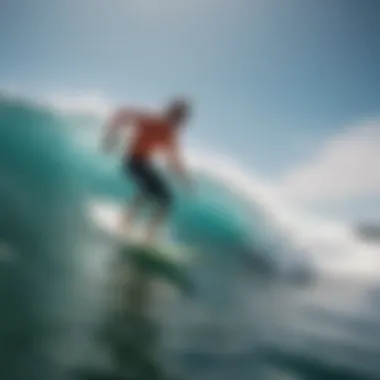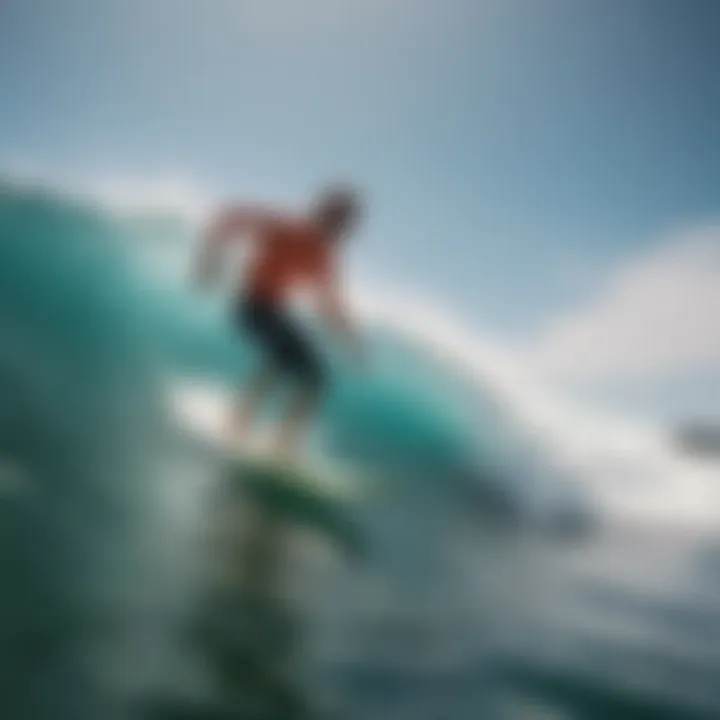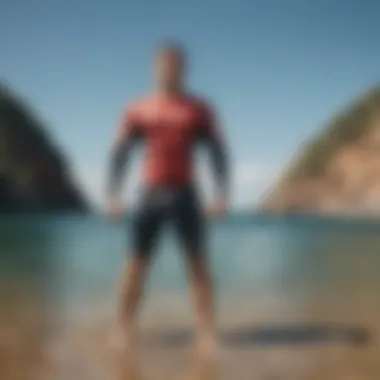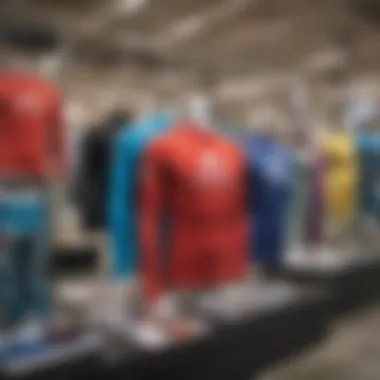The Rise of Recycled Rash Guards in Watersports


Intro
The growing awareness of environmental issues has spilled over into various facets of our daily lives, and watersports are no exception. Those who enjoy activities like surfing, kayaking, and paddleboarding are increasingly considering the impact of their gear on the planet. Enter the trend of recycled rash guards. Made from repurposed materials, these pieces not only protect you from the elements but also reflect a commitment to sustainability. This article will take a closer look at the phenomenon of recycled rash guards, exploring their construction, advantages, and the broader implications for the watersports community.
As water enthusiasts, it becomes imperative to understand how our choices can contribute to a healthier marine environment. Therefore, let's dive into the details:
- Material Composition: Examining what goes into recycled rash guards.
- Performance Benefits: Evaluating how these garments measure up to traditional options.
- Eco-Friendly Impact: Understanding the environmental implications of choosing recycled gear.
- Brand Initiatives: Highlighting companies that are leading the charge in eco-friendly practices.
Through this exploration, enthusiasts will gain insights into the importance of their gear, empowering them to make informed decisions that align with their values.
Foreword to Recycled Rash Guards
As the watersports community continues to expand, so does the responsibility of its enthusiasts to consider their impact on the environment. In this context, recycled rash guards emerge as both a practical choice and a symbol of eco-consciousness. Understanding the significance of these garments offers an entry point into a broader dialogue about sustainability within the industry.
Definition and Purpose
Recycled rash guards, designed primarily for water activities like surfing, paddleboarding, or snorkeling, are made from materials that have been repurposed rather than created anew. The development of these garments typically involves recycling plastic bottles and other synthetic materials, transforming waste into something functional and stylish.
The primary purpose of a rash guard is to protect the skin from harsh sun rays and irritants, such as surfboards and marine life. By opting for recycled versions, consumers contribute to reducing pollution while still enjoying the benefits of traditional models. These alternatives offer not only protection but also uphold a commitment to environmental stewardship, aligning the enjoyment of the waters with ecological consciousness.
Significance in Watersports
The growing interest in recycled rash guards reflects a significant shift in attitudes towards sustainability among water sports enthusiasts. With the escalating effects of climate change and plastic pollution, participants in these activities recognize that their choices must evolve.
Recycled rash guards play a pivotal role in this transformation. Consider the fact that a single rash guard has the potential to be made from several recycled bottles, turning potential ocean waste into wearable usefulness.
Incorporating such garments into one's watersport gear not only supports the reduction of waste but also encourages brands to prioritize innovation in product development. Consumers, by making more thoughtful choices, send a clear message that sustainable options are in demand.
"Wearing a recycled rash guard isn't just a fashion statement; it's a commitment to a healthier ocean and planet."
Whether you’re catching waves or simply enjoying the beach, opting for recycled products fosters a mindset that prioritizes the Earth's well-being. The shift to these eco-friendly alternatives acknowledges a collective responsibility, making every dive into the water also a dive into sustainable living.
Environmental Impact of Traditional Rash Guards
The pressing issue of environmental degradation nudges every industry to reconsider its practices. The watersports sector is no different, and understanding the environmental impact of traditional rash guards is key to appreciating the advantages of their recycled counterparts. Traditional rash guards, while serving their purpose in terms of performance and protection, carry a hidden cost that goes beyond their initial function. Here, we dissect two crucial components affecting our ecosystem: material sourcing and pollution, followed by waste generation and its aftermath.
Material Sourcing and Pollution
Traditionally, rash guards are often crafted from synthetic materials like polyester and nylon, which are petroleum-based. The extraction of these materials can be anything but environmentally friendly. Oil drilling and refining not only deplete non-renewable resources but also cause numerous ecological issues like oil spills, habitat destruction, and toxic emissions. Manufacturing these fabrics releases pollutants into the water and air, ultimately affecting marine life.
- Production Footprint:
- The energy-intensive process to produce polyester emits significant greenhouse gases. Each step, from extraction to production, compounds the environmental footprint.
- Water-based toxic dyes used in coloring these garments contain cancer-causing agents and are often improperly disposed of, entering waterways.
If you need direct proof of the damage, consider this: it’s estimated that roughly 70 million barrels of oil is required annually for polyester production. This is not just a number; it reflects on our beaches, communities, and oceans.
"Every traditional rash guard bought without consideration leaves a tangible footprint on our environment."
Waste Generation and Landfills
The lifecycle of a traditional rash guard doesn’t end once it’s worn out. These garments can take hundreds of years to decompose in landfills, primarily due to their synthetic composition. When discarded, they contribute to the growing problem of textile waste.
- Longevity in Landfills:
- Microplastic Leakage:
- A polyester rash guard may linger in a landfill for as long as 200 years. Each year, countless tons of these materials end up in overflowing landfills, leading to soil and water contamination.
- Furthermore, as these garments break down, they shed microplastics, which find their way into oceans, affecting marine populations from plankton to whales.
Awareness of these critical issues is essential not just for individual consumers but also brands aiming to create a more sustainable future in the watersports community. The onus is on us to change our purchasing habits and embrace eco-friendly alternatives, such as recycled rash guards, adding new value to our environment while we enjoy our beloved water activities.


What Constitutes a Recycled Rash Guard
Understanding what makes a rash guard recycled goes beyond merely slapping a label on a product. It touches on the core of sustainability within the watersports industry, where conscious consumerism is gaining traction. Recycled rash guards are pivotal not only in reducing waste but also in redefining how we engage with the ocean and water sports. This section explores the materials that constitute these garments and the intricate manufacturing processes that transform discarded materials into high-performance gear.
Materials Used in Production
When it comes to recycled rash guards, the magic often starts with plastic waste. More specifically, many brands use recycled polyester, typically derived from discarded plastic bottles. This journey starts when these bottles are collected, usually from curbside recycling programs or cleanup initiatives, which keeps them out of landfills. They’re then cleaned and sorted before being processed into small plastic pellets. These pellets are then spun into fibers that can be woven into fabric for rash guards. Here are a few materials commonly utilized in their production:
- Recycled Polyester (rPET): This is the most common material used. It’s durable and quick-drying, making it ideal for water sports.
- Nylon Spandex: Some recycled rash guards incorporate spandex, giving them elasticity and comfort. Recycled nylon, sourced from textile waste, is used for this purpose.
- Organic Cotton Blends: A few brands are experimenting with mixing recycled polyester with organic cotton to provide softness while remaining eco-friendly.
Using these materials not only decreases reliance on virgin resources but also contributes to significant energy savings during production. For instance, manufacturing from recycled materials usually requires less energy than producing from raw materials, leading to a decreased carbon footprint.
Manufacturing Processes
The path from waste to wearable involves meticulous processes that ensure quality while maintaining sustainability. The steps in manufacturing recycled rash guards involve several key phases:
- Shredding and Cleaning: Collected plastic bottles are first shredded into tiny pieces, and contaminants are removed to ensure purity.
- Extrusion: The clean plastic shreds are melted and forced through a spinneret to create long strands of filament. This is known as extrusion, and it’s a pivotal moment where waste begins its transformation.
- Fiber Spinning: The strands are then cooled and spun into threads. This phase may involve dying the fibers, an area where brands can choose eco-friendly dyes.
- Weaving: The threads are woven into fabric using traditional textile techniques. A variety of weaves can enhance features such as stretch or durability, catering to the specific needs of water sports enthusiasts.
- Finishing Touches: Finally, treatments might be applied to the fabric to enhance performance, such as UV protection or anti-chafing properties.
The entire manufacturing process generally has a lower environmental impact compared to producing conventional rash guards from non-recycled materials. Every step is designed not only to be efficient but also to minimize waste and pollution.
"Opting for recycled materials isn't merely a trend; it’s a step toward a more sustainable future in watersports."
In summary, exploring the materials and manufacturing processes behind recycled rash guards reveals a broader commitment to sustainability. They stand as a testament to innovation and responsible consumer choices, embodying a forward-thinking approach to our enjoyment of water sports.
Benefits of Using Recycled Rash Guards
The shift towards recycled rash guards isn't just a passing trend in the watersports community; it's a pivotal change in how enthusiasts view their gear and its impact on the environment. More than focusing solely on aesthetics or individual performance, many paddlers, surfers, and divers are waking up to the reality that their choices can have deep environmental consequences. In this section, we’ll break down the distinct benefits of using recycled rash guards, touching on their environmental friendliness and performance capabilities, all while keeping in mind what matters to the serious outdoor adventurer.
Environmental Advantages
One of the most significant points that pops to mind regarding recycled rash guards is their potential for reducing environmental harm. Traditional rash guards are typically made from new synthetic materials, often derived from petroleum. This process not only consumes valuable natural resources but also generates considerable waste and emissions. In stark contrast, recycled rash guards are typically crafted from post-consumer plastics, such as discarded water bottles and fishing nets.
The environmentally friendly aspects can be summarized as follows:
- Waste Reduction: Recycling plastics into rash guards means less waste in landfills, and it helps to lower ocean pollution. This is key for preserving marine life.
- Conservation of Resources: By utilizing existing materials instead of virgin resources, these products help uphold resource conservation efforts, thus making for a more sustainable cycle.
- Reduced Carbon Footprint: Manufacturing items from recycled materials generally requires less energy. This translates to a lowered carbon footprint, contributing positively to combating climate change.
"Every recycled rash guard is a step towards cleaner oceans and healthier beaches. Every choice counts."
These advantages provide a compelling reason for watersports enthusiasts to consider the environmental impact of their choices more seriously, and ultimately, to embrace gear that embodies our shared responsibility for the planet.
Performance Features
When it comes to performance, the watersports community often prioritizes gear that extends durability, comfort, and flexibility. Recent innovations in materials mean that recycled rash guards now also offer performance features that might surprise skeptics.
Some of the performance benefits include:
- Excellent Stretch and Recovery: Recycled materials can still provide adequate stretch properties similar to conventional options, ensuring that athletes can move freely without feeling constrained.
- Quick Drying and Breathability: Many top-notch recycled rash guards are still made from breathable fabrics that dry quickly, an essential feature for those on the water. This comfort factor can make or break a long day spent surfing or paddleboarding.
- Sun Protection: Just like their conventional counterparts, recycled rash guards often come equipped with UV protection, safeguarding outdoor adventurers from harmful sun rays during prolonged exposure.
It’s clear that recycled rash guards are not just a nod to sustainability but also a solid choice for performance. By shifting to recycled options, watersports enthusiasts do not have to compromise on the quality of their gear. They can enjoy their favorite pastimes while knowing they’re making a meaningful contribution to environmental stewardship.
Performance of Recycled Rash Guards
The performance of recycled rash guards represents a vital consideration for both consumers and manufacturers. As the trend of sustainability keeps gaining traction, knowing how these garments stack up against traditional options is key. Enthusiasts want reassurance that they aren’t sacrificing quality for eco-conscious choices. Key elements like durability, longevity, comfort, and fit all play a significant role in this assessment. Performance here doesn't merely focus on how these garments hold up under physical stress; it's also about how they contribute to an overall enjoyable experience while engaging in watersports.
Durability and Longevity
When diving into the durability of recycled rash guards, it becomes apparent they are not just a fleeting fad. Many have been crafted using advanced technologies that enhance their resilience. For example, recycled polyester, often derived from plastic bottles, can be just as sturdy as virgin polyester.
- Living Through Tough Conditions: Watersport enthusiasts know that the elements can be harsh. Whether it's saltwater, sand, or UV radiation, a quality rash guard must withstand these challenges.
- Wear Ain’t Scary: The durability of these garments means they can endure repeated use without losing their shape or performance. This translates into a longer lifespan with fewer replacements required over time. Think of it like investing in something that pays off in the long run.


The longevity factor is increasingly appealing for consumers who value both performance and sustainability. The fact that these products are built to last means less waste in the grand scheme of things. If you can wear a rash guard through multiple seasons, that’s a win for your wallet and the planet.
Comfort and Fit
Now, let’s talk comfort and fit. A snazzy rash guard isn't very useful if it makes you feel like you're wearing a sack of potatoes. Fortunately, many leading brands have honed in on creating well-fitting options that are comfy and functional.
- Emphasis on User Experience: Many recycled rash guards aim to feel as good as they look. Key features include:
- Moisture-Wicking Fabric: Keeps sweat at bay, so you can focus on catching that wave instead of fussing with discomfort.
- Four-Way Stretch: Enhances freedom of movement, whether you’re paddling out or throwing a trick.
- Chafe-Free Seams: Say goodbye to those nasty rashes and hello to a smooth experience.
A proper fit comes down to both size and design. Rash guards that are too tight can restrict motion, while overly loose options might slow you down. Many manufacturers now offer a range of fits, from snug options to looser cuts, catering to varying preferences within the community. For those who prioritize both performance and aesthetics, recycled rash guards are starting to tick all the right boxes.
"Sustainability doesn’t have to come at the cost of quality. Recycled rash guards prove that eco-friendliness and top-notch performance can go hand in hand."
Consumer Trends in the Watersports Community
As watersports gain traction amongst enthusiasts, particularly those keen on sustainability, understanding consumer trends has become crucial. The watersports community is witnessing an increasingly robust demand for eco-conscious products, with recycled rash guards leading the charge. Engaging with this trend not only reflects individual values but also shapes the market landscape in a meaningful way.
Shifting Attitudes Towards Sustainability
In recent years, there has been a noticeable shift in attitudes towards sustainability within the watersports community. Water sports enthusiasts are starting to connect the dots between their activities and their ecological footprint. Many have begun to recognize that their love for the ocean can coexist with a commitment to conserving it. This growing awareness has pushed brands to improve their practices and offer products that align with sustainable values.
People are increasingly questioning the origins of their gear. Questions like, "Where does this product come from?" and "What impact does it have on the environment?" are becoming the norm rather than the exception.
This mindset has not only led to a rise in recycled rash guards but has also fostered a deeper discussion about material sourcing and ethical manufacturing processes. Enthusiasts are more inclined to support companies that prioritize sustainability over mere profit margins. As one prominent figure in the industry stated,
"It's not just about riding the waves; it's about protecting the waters we love."
Demand for Eco-Friendly Products
The demand for eco-friendly products like recycled rash guards is at an all-time high, driving brands to step up their game. This trend isn’t just about aesthetics or marketing; it represents a deeper commitment to environmental preservation. Today’s consumer is well-informed and often bases their purchasing decisions on a brand’s sustainability initiatives.
Brands that fail to adapt may find themselves left in the dust as consumers vote with their wallets. Here are a few reasons why the watersports community is leaning toward eco-friendly options:
- Alignment with Personal Values: Many surfers and divers now see sustainable products as an extension of their identity. They want to wear their commitment to the environment, literally.
- Quality and Performance: Contrary to the misconception that eco-friendly products are inferior, many recycled rash guards are not only durable but also designed with advanced materials that enhance performance.
- Community Influence: Peer pressure works in positive ways here. When group members choose sustainable options, it creates a ripple effect, pushing others to follow suit.
As the watersports community embraces these changes, it's clear that the future is leaning towards more responsible consumerism. The focus on recycled apparel is becoming more than just a trend—it's part of a larger movement aimed at protecting our oceans and the ecosystems within them.
Brands Leading the Way
The realm of recycled rash guards is increasingly defined by innovative brands that prioritize sustainability without sacrificing quality or style. These companies not only produce eco-friendly products but also inspire a community of watersport enthusiasts to embrace greener practices. Understanding the brands at the forefront of this movement is vital for consumers who wish to make informed choices that reflect their values.
Innovative Companies in the Market
Some brands have really taken the bull by the horns, relentlessly exploring ways to merge performance with sustainability. For instance, Patagonia has carved a niche by utilizing materials derived from discarded fishing nets and plastics. Their commitment to quality means that their rash guards not only protect the wearer from sun and abrasion but also help reduce ocean pollution. Another standout is O'Neill, which has introduced their Next Wave line, featuring rash guards made from recycled bottles. This product line has received accolades for its blend of style and ecological mindfulness.
Here’s a closer look at a few more companies making waves:
- RIP CURL: Known for their ethos of “The Search”, they currently focus on developing products that reflect a commitment to environmental issues, utilizing recycled materials in their designs.
- Xcel: They’re embracing the future with their range of eco-friendly wetsuits and rash guards made from recycled rubber.
- Surf Rider Foundation’s Collaborations: They partner with various brands to push the envelope for sustainable materials in watersport clothing.
Sustainability Initiatives
The push for recycled rash guards is embedded in broader sustainability initiatives that these companies champion. For example, O'Neill initiated their “Changing the Tide” campaign, which aims to educate consumers about the impacts of ocean plastic. They’ve not only created products that address this issue, but also engaged communities to participate in clean-up activities.
Moreover, many of these brands are focusing on lifecycle assessments to measure their environmental impact. This is a crucial step since consumers need transparency regarding the sustainability of their purchases. Patagonia, for instance, provides detailed reports on the sourcing and production processes involved in their garments. They prioritize eco-friendly dyes and processes while maintaining a commitment to fair labor practices.
"Conventional manufacturing isn’t just about the product. It’s about everything that goes into making it sustainable—materials, labor, environmental impact, and ultimately the consumer's choice."


Incorporating recycled materials is just one facet of their efforts. Brands are also investing in technologies that reduce energy consumption during manufacturing, such as solar power and water-saving production methods. These initiatives not only reduce the environmental footprint of rash guards but also set an example for the industry, encouraging others to follow suit.
In summary, the brands leading the way in recycled rash guards are truly shaping the future of watersports apparel. Their innovative approaches and sustainable initiatives serve as inspirations for consumers and competitors alike. By choosing to support these brands, watersport enthusiasts can contribute to a healthier planet while enjoying their time in the water.
Challenges in the Production of Recycled Rash Guards
The journey toward sustainability in watersports is not without its hurdles. As recycled rash guards become more popular, it's crucial to address the challenges involved in their production. These obstacles not only affect the manufacturing process but also impact the overall appeal of recycled products to consumers. Understanding these challenges provides a broader perspective on the industry’s current state and future direction.
Material Limitations
In the production of recycled rash guards, one significant hurdle is the limitations of the materials used. Traditional rash guards often rely on new synthetic fibers like polyester. When turning to recycled options, the sources of these materials can vary immensely. Generally, recycled fibers come from post-consumer plastic bottles or discarded textiles. The recycling process can only yield materials of a certain quality, which may not match the performance characteristics of virgin textiles.
Some manufacturers face challenges sourcing enough high-quality waste to meet demand. In fact, even the recycling processes can leave some contaminants in the fabric, which ultimately could affect durability or comfort when worn. Moreover, not all plastics are easily recyclable; the type of plastic used has an impact on its end-use.
This inconsistency can lead to variability in rash guard quality. Some may excel in comfort and elasticity, while others may falter. Therefore, brands often have to invest heavily in research and development to improve recycling techniques and material performance.
Cost Comparisons
Cost is another barrier to the broader adoption of recycled rash guards. Even as consumers become increasingly eco-conscious, price tags that come with recycled materials can be elevated. The processes involved in converting waste into usable textile fibers are generally more expensive than using newly produced materials. This cost can trickle down to the end user, leading to higher retail prices.
For instance, while a typical synthetic rash guard can be purchased for a reasonable price, its recycled counterpart may demand a premium. Shoppers might have to weigh their eco-friendly choices against their budgets, which could deter some from investing in sustainable options. Many consumers might perceive recycled products as niche, linking them with higher costs or limited availability compared to mainstream products.
"While consumer interest in sustainability is on the rise, translating that into sales of eco-friendly products can be challenging, especially when cost is a concern."
To tackle these financial challenges, brands may explore economies of scale, seek grants for sustainability initiatives, or collaborate to create a shared supply chain for recycled materials. Addressing the costs associated with production while still offering competitive pricing remains a complex puzzle for brand managers.
Overall, the journey of recycled rash guards from conception to market is laden with challenges, but it’s crucial for both the industry and consumers to recognize these barriers. Tackling restrictions in material quality and mitigating production costs can lead to advancements that make these sustainable products not just an option but a standard in the watersports community.
The Future of Recycled Rash Guards
The landscape of watersports is changing, and the future of recycled rash guards stands at the forefront of this transformation. As more people become aware of the environmental issues tied to traditional sporting gear, the shift toward sustainability isn't just a trend; it's reshaping the foundations of the industry. Understanding this future is crucial, particularly for enthusiasts looking to make informed choices that align with their values. This section will delve into innovations on the horizon and potential industry shifts, providing a glimpse into a greener, more responsible watersports culture.
Innovations on the Horizon
Innovation is the lifeblood of any thriving industry, and the world of recycled rash guards is no exception. Companies are exploring new materials and processes that could enhance the functionality of these eco-friendly garments while minimizing their environmental footprints. For instance, there is ongoing research into advanced fabric technologies that make use of waste plastic from oceans and rivers. By transforming these materials into high-performance textiles, manufacturers can dramatically decrease the volume of plastic entering landfills.
Additionally, we are seeing the emergence of bio-based materials. These fabrics are derived from renewable resources, such as algae and agricultural waste, offering an exciting alternative to petroleum-based synthetics. Such innovations not only reduce dependency on fossil fuels but also contribute to a closed-loop production system, where waste becomes the raw material for new products.
The production processes themselves are also evolving. Techniques like 3D printing might soon play a role in manufacturing rash guards, allowing for more efficient use of materials with less waste. Companies are prioritizing transparency in their supply chains as well, with consumers increasingly wanting to know where their clothes come from and how they’re made. This accountability fosters a deeper connection between brands and consumers.
"Sustainable innovation is not just about new materials; it's about rethinking the entire lifecycle of a product."
Potential Industry Shifts
As recycled rash guards gain traction, we can expect notable shifts within the broader watersports industry. Firstly, consumer demand is creating a ripple effect, with brands feeling the pressure to adapt to changing preferences. If a significant portion of the market leans towards eco-friendly options, it prompts companies to reconsider their environmental impact seriously.
Furthermore, the conversation around sustainability isn't confined merely to production. It extends to marketing strategies too. Brands are reassessing their messaging, moving away from fast fashion styles towards a model that emphasizes quality, longevity, and environmental responsibility. This might lead to a culture shift where durability is valued over trends, compelling consumers to invest in rash guards that stand the test of time.
In addition, partnerships between brands and environmental organizations are likely to rise. Collaborations aimed at clean-up initiatives or marine conservation can forge stronger ties to the community, while enhancing brand credibility. This collaboration can foster a collective responsibility toward ocean conservation efforts, showcasing that the industry is more than just a market; it is part of a larger ecosystem that requires stewardship.
As watersports enthusiasts look forward to a future filled with possibilities, the call for sustainable actions remains vital. Through innovation and shifts in consumer behavior, recycled rash guards hold the potential to significantly impact the industry for the better, heralding a new era of eco-conscious watersports.
Culmination
As we come to the end of our exploration into recycled rash guards, it’s clear that this topic is more than just a trend in the watersports community. The importance of understanding the impact of our choices—both environmentally and personally—provides a framework for a more thoughtful approach to our outdoor adventures. Recycled rash guards embody a convergence of performance, sustainability, and responsibility, which resonates deeply with modern consumers.
Recap of Key Points
- Definition and Purpose: Recycled rash guards are crafted from materials that reduce waste, thus providing an effective solution to the pollution issues related to traditional gear.
- Performance Advantages: These guards not only minimize environmental impact but also offer durability, comfort, and excellent fitting, ensuring that watersport enthusiasts can perform at their best.
- Consumer Trends: There's a shifting attitude among consumers towards more sustainable choices, with an increasing demand for eco-friendly products, including recycled swimwear.
- Brand Initiatives: Several innovative companies are leading the way, implementing sustainability initiatives that emphasize the use of recycled materials in their product lines, which also encourages a greater awareness among consumers.
- Challenges: Despite their benefits, challenges persist, such as material limitations and cost factors, which need to be addressed to make recycled options more accessible to a wider audience.
Call to Action for Consumers
The journey towards a more sustainable watersports culture starts with informed choices. As an outdoor adventurer or water sports enthusiast, consider the following:
- Choose Wisely: When purchasing, opt for brands that prioritize recycled materials. This supports sustainable business practices and encourages others in the industry to follow suit.
- Spread the Word: Share your knowledge about recycled rash guards within your community. Conversations could lead to more widespread consumer demand for eco-friendly options.
- Stay Informed: Keep an eye on evolving trends and innovations within the industry. By staying engaged, you can help drive meaningful changes in production practices.
- Participate in Initiatives: Get involved in environmental initiatives or community clean-ups that ultimately help reduce waste and promote sustainability in your local area.















